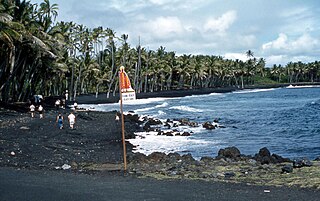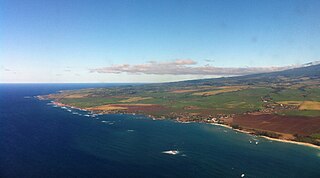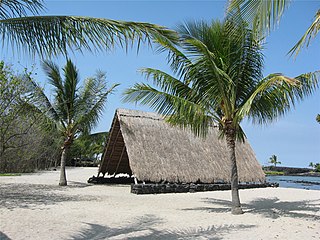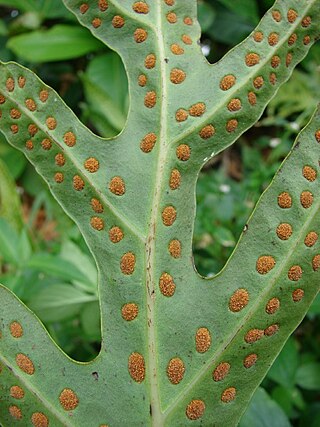
Kaimū was a small town in the Puna District on Island of Hawaiʻi that was completely destroyed by an eruptive flow of lava from the Kūpaʻianahā vent of the Kīlauea volcano in 1990. In Hawaiian, kai mū means "gathering [at the] sea" as to watch surfing. The lava flow that destroyed Kaimū and nearby Kalapana erupted from the southeast rift zone of Kīlauea.

ʻIolani Barracks, or hale koa in Hawaiian, was built in 1870, designed by the architect Theodore Heuck, under the direction of King Lot Kapuaiwa. Located directly adjacent to ʻIolani Palace in downtown Honolulu, it housed about 80 members of the monarch's Royal Guard until the overthrow of the Monarchy in 1893. It was added to the National Register of Historic Places in 1978 as part of the Hawaii Capital Historic District.

The Makahiki season is the ancient Hawaiian New Year festival, in honor of the god Lono of the Hawaiian religion.

Haiku is an unincorporated community in Maui County on the island of Maui in the state of Hawaii. For United States Census purposes, it is part of the Haiku-Pauwela census-designated place, which also includes Pauwela.

Pandanus tectorius is a species of Pandanus (screwpine) that is native to Malesia, Papuasia, eastern Australia, and the Pacific Islands. It grows in the coastal lowlands typically near the edge of the ocean. Common names in English include thatch screwpine, Tahitian screwpine, hala tree and pandanus. The fruit is edible and sometimes known as hala fruit.

Kaloko-Honokōhau National Historical Park is a United States National Historical Park located in the Kona District on the Big island of Hawaiʻi in the U.S. state of Hawaiʻi. It includes the National Historic Landmarked archaeological site known as the Honokōhau Settlement. The park was established on November 10, 1978, for the preservation, protection and interpretation of traditional native Hawaiian activities and culture.

Fagraea berteroana, commonly known as the pua keni keni, pua kenikeni or perfume flower tree, is a small spreading tree or a large shrub which grows in the sub-tropics, where temperatures are 10 °C or more. It is indigenous to the Samoa Islands where it is known as the pua-lulu plus in Tonga and Tahiti as pua. Its occurrence spans from New Caledonia to eastern Polynesia. The ITIS database clarifies the spelling of the name.

Pulu is a silky material obtained from the fibers of the hapuʻu pulu, a tree fern of Hawaii. It is made of the brown hairs that cover the young fiddlehead as it uncoils.

Hāʻena State Park is a state park on the north shore of the Hawaiian island of Kauaʻi. It is often called the "end of the road" and marks the endpoint of the Kuhio Highway. The park provides access to beaches, trails, and several ancient Hawaiian sites, including sea caves estimated to be more than 4,000 years old. Archaeological sites associated with the hula, including a heiau (shrine) dedicated to Laka, are above the park's beaches.

Kēōkea is an unincorporated populated place in Hawaiʻi County, Hawaii, United States. It is located at 19°25′10″N155°52′58″W, near the junction of Māmalahoa Highway and Keala o Keawe Road, elevation 960 feet (290 m). Satellite imagery shows evidence of a humid climate with agriculture dominant around the settlement. Just to the north is the area of Hōnaunau. It was the name for the land division (ahupuaʻa) of ancient Hawaiʻi that stretched from the shoreline to Mauna Loa owned by Mataio Kekūanaōʻa.

Samuel Mahuka Spencer was a Hawaiʻi island politician.

Makana is a mountain located on northern shore of the island of Kauaʻi, where it rises 1,115 feet (340 m) above Limahuli Valley. Makana is a Hawaiian language term meaning gift or reward. It is often used as a person's name or as part of a name. Limahuli Garden and Preserve preserves the valley below. It was featured in the 1958 film adaptation of the musical South Pacific as Bali Haʻi and is known by that name.

The Hawaiian flagtails are species of the genus of flagtail fishes found in the Hawaiian Islands. Two species are Kuhlia sandvicensis and K. xenura. K. xenura is endemic to the islands.
Nīnole is the name of two unincorporated communities on the island of Hawaiʻi in Hawaiʻi County, Hawaii, United States. In the Hawaiian language Nīnole means "bending". Nīnole also has the highest percentage of people of Italian descent in Hawaii.
ʻĀpua was an ancient village in the Puna district on the southern coast of the Island of Hawaiʻi in the Hawaiian Islands. A small fishing village was located at about 19°15′41″N155°11′46″W, an elevation about 59 feet (18 m) above sea level. The village was destroyed by a tsunami following the April 2, 1868 Hawaii earthquake and never resettled.

Hoʻolulu (1794–1844) was a member of the nobility during the formation of the Kingdom of Hawaii. He was a trusted advisor to King Kamehameha I, also known as "Kamehameha the Great", and was one of the select few to know his secret resting place. His descendants continue the tradition of guarding royal burials. A major cultural site in Hilo, Hawaii is named after him.
Pāʻauhau is an unincorporated community on the island of Hawaiʻi in Hawaiʻi County, Hawaiian Islands. Pāʻauhau is located near the north coast of the island, 2 miles (3.2 km) east-northeast of Honokaʻa.
Kanikapila is a style of Hawaiian music produced in an impromptu jam session, most commonly taking place at a beach, or family gathering. The term comes from kani which means sound. and pila which means any string instrument in the Hawaiian language.

Microsorum scolopendria, synonym Phymatosorus scolopendria, commonly called monarch fern, musk fern, maile-scented fern, breadfruit fern, or wart fern is a species of fern within the family Polypodiaceae. This fern grows in the wild in the Western Pacific rim from Australia to New Caledonia to Fiji and throughout the South Pacific to French Polynesia.
Ahalanui is the name of an ahupuaʻa and was the Hawaiian name for a Hawaiʻi County-managed beach park in the district of Puna. During the 2018 lower Puna eruption the area was covered by lava.


















